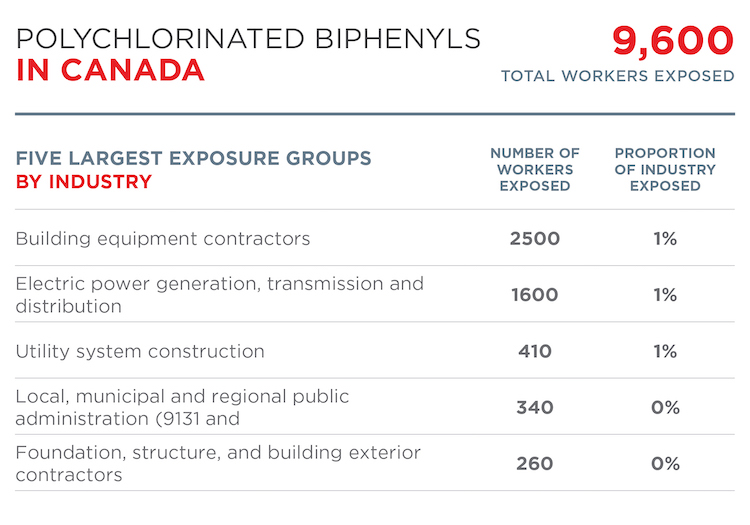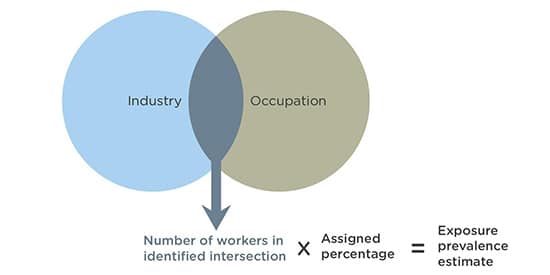Polychlorinated Biphenyls Occupational Exposures
Polychlorinated Biphenyls Occupational Exposures
Overview
Inhalation, dermal absorption and ingestion are all potential routes of occupational exposure to PCBs.[1]
CAREX Canada estimates that approximately 9,600 Canadians are exposed to polychlorinated biphenyls in their workplaces. The largest industrial groups exposed are building equipment contractors and electric power generation, transmission, and distribution. Other important industries exposed to PCBs are utility system construction, public administration, and foundation, structure, and building exterior contractors.
READ MORE...
The largest occupational groups exposed to PCBs include industrial electricians, contractors and supervisors in electrical and telecommunication trades, electrical power line and cable workers, and electrical mechanics. Other occupational exposures may occur in workers involved in waste storage and incineration, and contaminated site remediation.[2,3] Welders and general maintenance workers in various industries may also encounter PCBs in old industrial paints and coatings.[2] Exposure may also occur during accidental spills or fires involving equipment containing PCBs.[1,4]
Prevalence Estimate
Results show that 9,600 Canadian workers are potentially exposed to polychlorinated biphenyls (PCBs) at work; 95% of these workers are male. Industries with the largest numbers of exposed workers include building equipment contractors (where most of the electricians are captured) and electric power generation, transmission, and distribution.
When exposure is examined by occupation, important occupational groups with the largest number of exposed workers include industrial electricians (3,000 workers exposed), contractors and supervisors in electrical and telecommunication trades (1,800 workers exposed), electrical power line and cable workers (1,300 workers exposed), and electrical mechanics (1,000 workers exposed).
The number of workers exposed to PCBs increased by approximately 1,400 workers from 2006 to 2016 (a 17% increase). This was primarily driven by an increase in the number of workers in the construction industry. Additional occupations with exposed workers were also identified in the waste treatment and disposal industry (NAICS 5622) and among janitors, caretakers and building superintendents (NOC 6733).
Workers exposed to PCBs by industry in 2016

Workers exposed to PCBs by region in 2016
Click the second tab to view total number of workers exposed.
* = < 50 workers
Methods and Data
Our Occupational Approach page outlines the general approach used to calculate prevalence and exposure level estimates for workplace exposures.
Data Sources
Data used in developing the occupational estimates for polychlorinated biphenyls (PCBs) were collected from several sources:
- The Canadian Workplace Exposure Database (CWED) contains approximately 200 measurements for PCBs exposure. These measurements were collected during the years 1981 to 2004 in Ontario and British Columbia workplaces.
- Canadian and US scientific peer reviewed publications that addressed PCBs exposure in Canada and the United States.
- Grey literature including technical reports from governments and international bodies.
Prevalence Estimate Method
CAREX defines exposure to PCBs as inhalation exposure at work to levels likely to exceed non-occupational exposure via indoor or outdoor air.
To determine the number of workers potentially exposed to PCBs at work, CAREX occupational exposure experts used methods previously established in other peer-reviewed CAREX projects in Europe. A series of steps were taken to assign exposure proportions to occupations and industries at risk of exposure to PCBs.

- Occupations and industries at risk of possible exposure to PCBs were identified using any combination of data sources described above.
- The total number of workers in each identified occupation and industry intersection was obtained from Statistics Canada 2016 census data.
- A percentage of workers exposed was assigned to that occupation and industry intersection. Percentages were determined by consultation with existing evidence in the data sources, previously established methods from the Europe CAREX estimates and the expert judgement of CAREX occupational hygienists.
- The number of workers in the identified group is multiplied by the assigned percentage to calculate the prevalence estimate of workers exposed to PCBs.
Sources
Subscribe to our newsletters
The CAREX Canada team offers two regular newsletters: the biannual e-Bulletin summarizing information on upcoming webinars, new publications, and updates to estimates and tools; and the monthly Carcinogens in the News, a digest of media articles, government reports, and academic literature related to the carcinogens we’ve classified as important for surveillance in Canada. Sign up for one or both of these newsletters below.
CAREX Canada
School of Population and Public Health
University of British Columbia
Vancouver Campus
370A - 2206 East Mall
Vancouver, BC V6T 1Z3
CANADA
As a national organization, our work extends across borders into many Indigenous lands throughout Canada. We gratefully acknowledge that our host institution, the University of British Columbia Point Grey campus, is located on the traditional, ancestral, and unceded territories of the xʷməθkʷəy̓əm (Musqueam) people.



